The Classic Games of Metagaming: Ogre
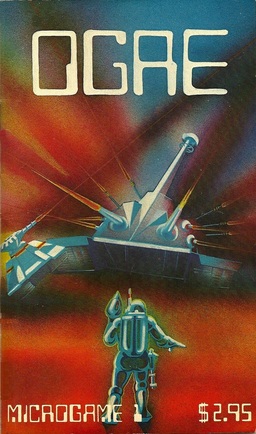 Last week, I wrote about discovering early Metagaming advertisements in copies of Analog and Asimov’s SF, as well as other science fiction magazines I read in the late 1970s. The ads — for tiny science fiction games I could carry around in my pocket — fired my imagination.
Last week, I wrote about discovering early Metagaming advertisements in copies of Analog and Asimov’s SF, as well as other science fiction magazines I read in the late 1970s. The ads — for tiny science fiction games I could carry around in my pocket — fired my imagination.
I was already gaming with my friends over lunch at school and the thought of playing games featuring giant robot tanks and wizard duels instead of another round of chess was too much to resist. I mailed off my check and waited impatiently for my treasures to arrive.
Now, ask most young folks how they felt when the magical item they ordered from the back of a comic or magazine finally came in the mail and you’ll hear some pretty sad stories. Those X-ray spectacles? A crushing disappointment. That family of sea monkeys? In reality, tiny frozen shrimp. And don’t even ask about the Polaris Nuclear Submarine.
But Metagaming microgames were not disappointments. Quite the opposite.
Microgame #1: Ogre was one of the first games I ordered from Metagaming. It was not the last. I still remember the first trial games I played with my brother Mike; the thrill of moving my Ogre cybertank relentlessly across the heavily cratered map board. Ogre was a wonderful game — brilliantly simple in design, easy to set up, and lightning fast to play.
It became, in fact, one of the most successful science fiction board games ever published, selling hundreds of thousands of copies. It went through numerous editions, and is still in print and available today — in both a no-frills reprint of the original 1977 edition and a limited edition deluxe version with multiple giant mapboards, more than 500 oversized full-color unit counters, and 3-D models, which will run you over $150 (if you can find a copy).
[Click on any of the images for larger versions.]
But I didn’t know any of this in 1978. All I knew was that this little $2.95 microgame was much simpler and more engaging — was more fun — than the big heavy Avalon Hill war games I’d spent so much money on.
Orge became our new lunch game. We played it over and over. In concept it was delightfully simple… the year was some time in the later 21st century. Advances in AI (following the creation of the first true mechanical intelligences in 2010) had revolutionized tank mechanized warfare. Human-driven tanks had been replaced with robot cybertanks, massive war machines that couldn’t be destroyed with conventional weaponry — they could only be slowed, and sometimes stopped, by destroying their weapons and means of locomotion.
Ogre was designed by Steve Jackson, who readily admitted the concept wan’t original. If you’d been reading science fiction for any period of time in the 1970s, you came across the concept of the supertank.
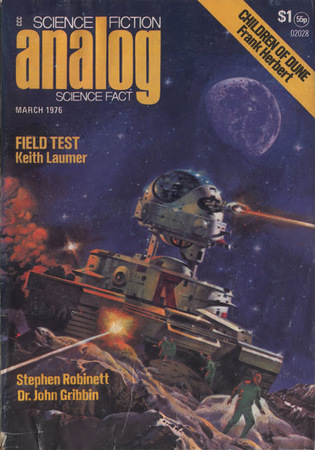 |
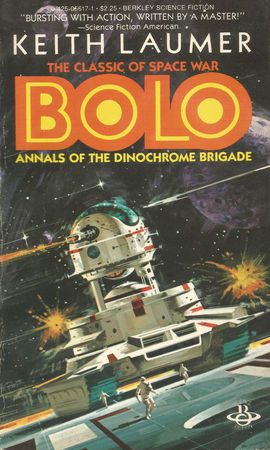 |
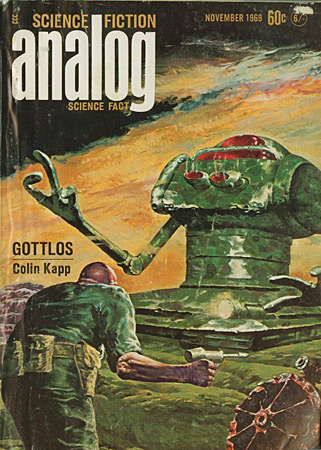 |
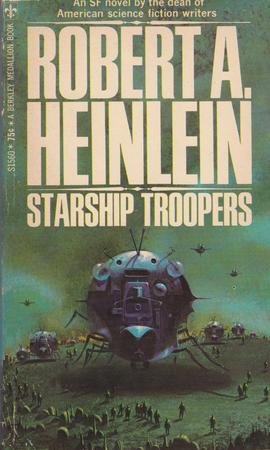 |
On the page 1 Jackson acknowledged his debt to several science fiction writers and series, including Keith Laumer’s Bolo books (originally published in Analog magazine, the same magazine I later found Ogre advertised in), Colin Lapp’s “Gottlos” stories (which also appeared in Analog), Joe Haldeman’s The Forever War, and Robert A Heinlein’s Starship Troopers.
Ogre was a slender little game, about the size of a paperback. It contained a 16–page rulebook, a map, and a set of counters. The back included a nice summary, and a mention of the sequel, G.E.V.
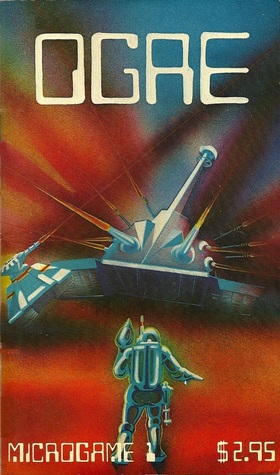 |
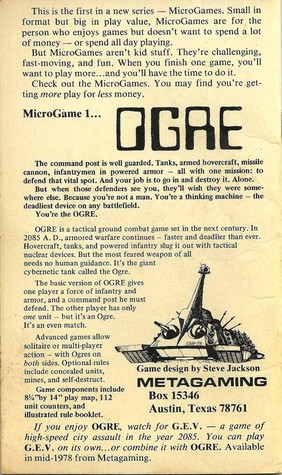 |
The map was simple enough, and nicely evocative of a blasted, post-apocalyptic landscape.
The premise was simple. Player one controlled a Command Post, and a force of heavy tanks, missile tanks, infantry, howitzers, and fast-moving armored hovercrafts, or ground effect vehicles (GEVs’).
Player two had only one unit: an Ogre.
There were multiple scenarios, but they mostly boiled down to this: player one set up on the board first. Her Command Post was immobile, and essentially defenseless. The Orge entered from the far side of the board, and inexorably made its way towards the Command Post. If it could destroy the CP, it won the game. Player one could win by critically disabling the ogre so that it was incapable of moving or firing effectively.
Games could be set up in under two minutes, and played in 8-15 minutes. You could play 2-3 rounds over a lunch hour, if you acted fast.
The game design and the quick-play weren’t the only things Ogre had going for it. A game this simple relies heavily on the players’ imagination to provide atmosphere and fill in the gaps, and Steve Jackson knew this. Jackson wasn’t just a talented designer; he was also a gifted writer, and in the first few pages he sketched out an intriguing future history that put the development of the Orge — and the terrifying impact it had on civilization — nicely in context. His game scenarios, desperate defending actions against a terrifying war machine, had weight and emotional impact well out of proportion to their brief descriptive paragraphs.
When you sat down to play a game of Ogre, you weren’t just pushing cheap cardboard counters across a piece of paper, and rolling a d6 you stole from your sister’s Clue game. You were a participant in a mini theater of the imagination. The stakes were perilously high for your human defenders as they valiantly surged across the blasted landscape towards an unstoppable enemy of mankind, and almost certain death. Every game brought surprises, and the kind of high drama and excitement that kept you and your friends talking for days — or at least until the next time the board came out.
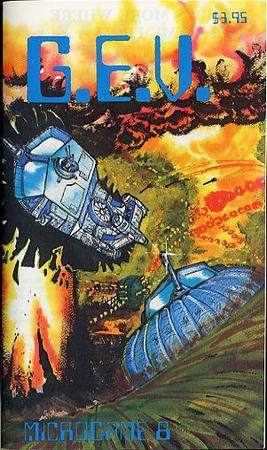 |
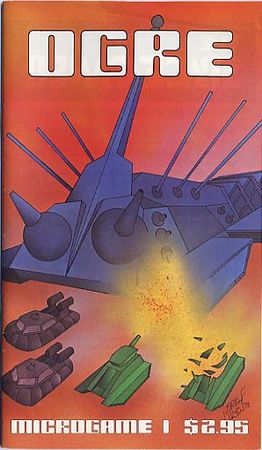 |
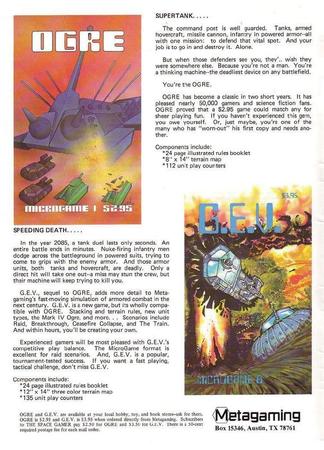 |
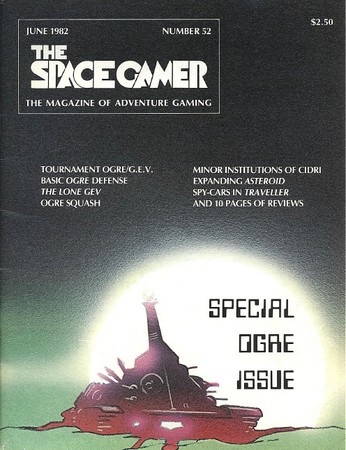 |
Metagaming was a small company with a very limited advertising budget, so it took a while for word to spread about the new line of microgames, and Ogre in particular. But spread it did. Orge became a certified hit. A sequel, also designed by Steve Jackson, appeared in 1978: G.E.V, focusing on the fast-moving ground effect vehicles (above left).
In many ways G.E.V. was a deluxe version of Ogre: it had a larger map, added new counters and more detail to the back story, and cost a buck more ($3.95). The games could be combined, of course, if you had the ambition to do such a thing.
A second edition of Ogre, with a new cover but still shipping in a plastic bag, was also released some time in the late 70s or early 80s (above, second from left). The company began to advertise the two games together, such as in the color ad from a 1979 issue of Space Gamer (above, second from right. Click for legible version.)
Steve Jackson left Metagaming and founded Steve Jackson Games in 1980, and the rights to both Ogre and GEV reventually reverted to him as part of a court settlement. Jackson proved to be an astute businessman as well as a talented game designer. He released a new version of Orge under the Steve Jackson name, improving the packaging by putting the game in a sturdy plastic box, rather than the simple plastic baggie that was Metagaming’s trademark. He also published new support material for the game, including the special Ogre issue of the Space Gamer magazine, issue #52 (above right).
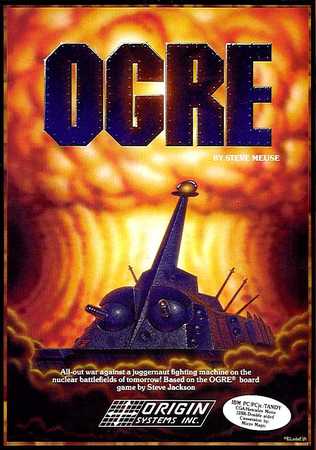 |
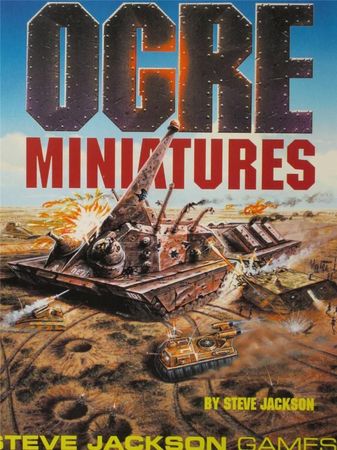 |
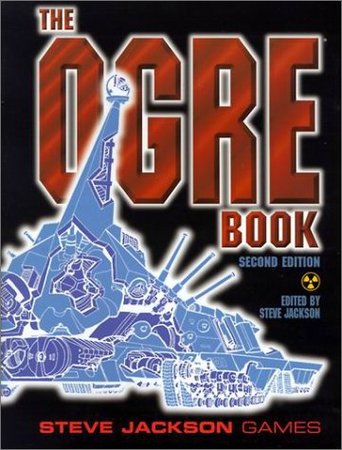 |
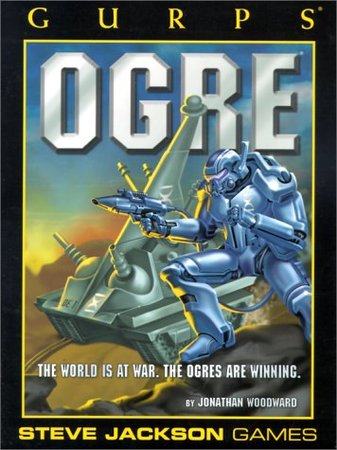 |
Ogre remained in print, in one fashion or another. throughout most of the 80s, 90s, and 00s. There were also many expansions, add-ons, spin-offs, adaptions, and what not. I won’t cover them all here, but I will mention a few of my favorites.
Origin Systems — famed publishers of the Ultima and Wing Commander games, among many others — published a computer game version of Ogre in 1986 (above left), releasing it for Apple II and Commodore 64 computers. The game was coded by Steve Meuse. It’s crude by modern standards, of course, but we loved it at the time.
Steve Jackson produced a line of Ogre Miniatures (second from left) in 1992, a logical development when you think about it. Who wouldn’t want a miniature Ogre? Moving cardboard counters around a game board is one thing, but trust me: the game is vastly more impressive when you have a to-scale mechanized behemoth, bristling with weapons, to move around instead. It won the Origins Award for Best Miniatures Rules of 1992.
Steve Jackson released The Ogre Book in 2001. Its 128 pages were packed with scenarios, variants, strategy, design notes, new units, an expanded alternate history, cartoons, fiction, and concept art for Ogre and G.E.V. It collected the best Ogre-related material from Space Gamer and Pyramid magazines, alongside some completely new articles. You’ll want to get the Second Edition if you can.
GURPS, the Generic Universal Role Playing System, published a GURPS Ogre role playing supplement in 2002. I don’t know much about it, but I absolutely love the tag line (“The World is at War. The Ogre are Winning.”)
If you’re just interested in playing the core game, you have several versions to choose from. Collectors have driven up the price of the original pocket editions to $10-$20 — although over 100,000 copies were sold, so don’t let anyone tell you they’re rare. Those early editions were flimsy, so expect copies in pristine condition to run you $25 or more.
Later editions might be a better bet anyway. One of my favorite versions is the boxed Ogre Deluxe Edition (above) from Steve Jasckson games. This one has sturdier components than the original baggie versions, although it’s also a little harder to find. It did re-use Denis Loubet’s cover from the 1986 computer game version… but it’s a fine cover, and I don’t mind so much.
There was also a reprint edition, priced at $2.95, of the original Metagaming baggie edition, released a few years ago; that one is not too hard to find.
If you’re drawn to the miniature version, your best bet is Deluxe Ogre (below), also from Steve Jackson. It includes 38 metal miniatures, including an Ogre Mark III, Combine armor and infantry, and a giant 35″ x 22″ map. Here’s the front and back (click for bigger versions.)
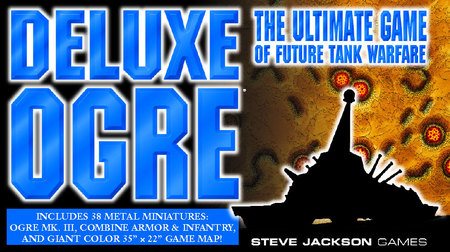 |
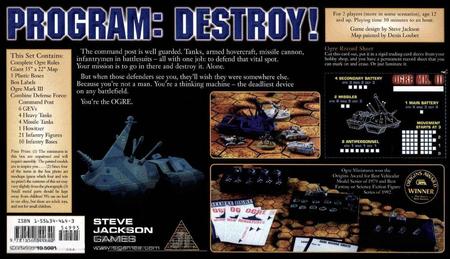 |
Finally, if money is no object, then the best version of Ogre to get — and indeed, one of the most deluxe versions of any game ever made, is of course the Ogre Designer’s Edition.
This thing is a true behemoth. Weighing in at 14 pounds (!!), it’s the result of the fabulously successful Kickstarter campaign that ended on May 11, 2012. Its funding target was $20,000; it raised an astonishing $923,680. Steve Jackson Games plowed most of that money into making the supreme edition of Ogre, a game of a scale that will likely not be seen again for a long time. It contains huge maps and hundreds of components. It is sold out, copies currently run around $150+ in the after-market.
We’ve previously covered several microgames, including
Melee and Wizard by Metagaming
The Lords of Underearth by Metagaming
The Awful Green Things From Outer Space by Steve Jackson Games
Valkenburg Castle, by Task Force Games
Swordquest, by Task Force Games
Barbarian Kings by SPI
Barbarian Prince, by Heritage Games
At Empire’s End, by Dark City Games
S.O.S, a complete Legends of Time and Space game by Dark City Games
The Island of Lost Spells and Wolves on the Rhine, by Dark City Games
A survey of Dark City Games
Next up: Microgame #2: Chitin. See you then!
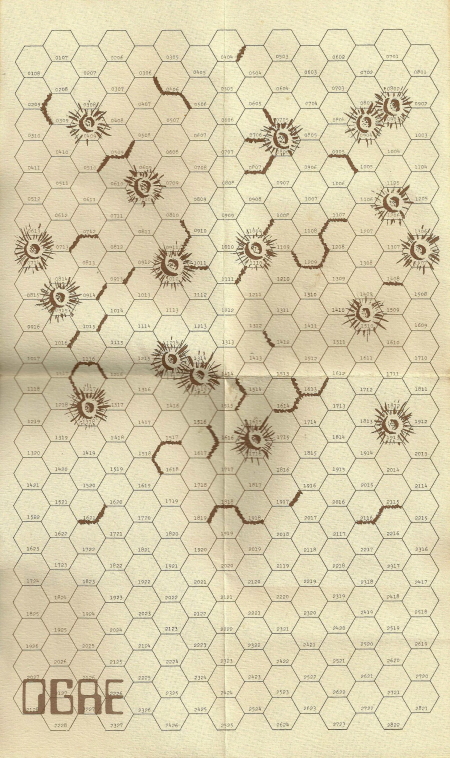
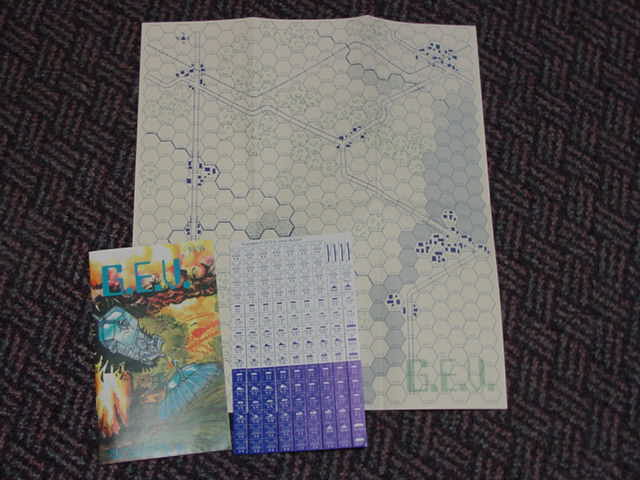
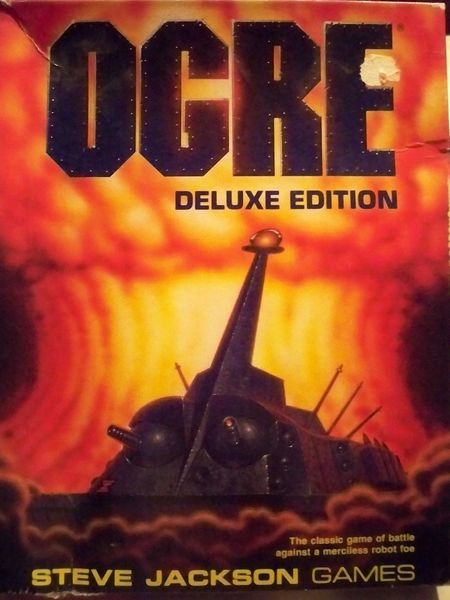
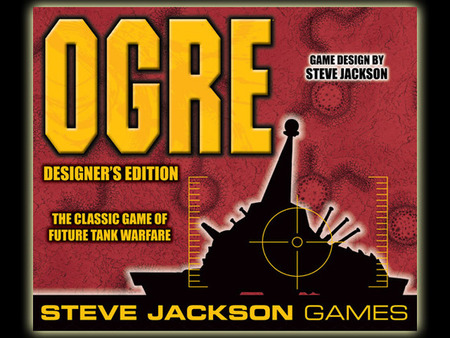
I found it very weird that there was a GURPS supplement for OGRE. Its not a world I want to roleplay in–its a world I want to wargame in
Great piece. OGRE was such a fun, quickly played game.
Outstanding article, John. Microgames were also my intro to the gaming universe: OGRE, Rivets, and Warp War started me on the long, downward spiral to RPGs. 🙂 And if it wasn’t for gaming, I never would have written. And we never would have met. So you can blame Steve Jackson for that one! 🙂
> I found it very weird that there was a GURPS supplement for OGRE
Prince,
I know, right? I don’t own a copy, so I can’t tell you much about it. But I spent a lot of time imagining I was in the Ogre universe while pushing little cardboard counters around a map board… I guess a supplement that allows you to role play in that Universe is the next logical step.
In addition, I remember being hungry for more information — of all kinds — about the Ogre universe in those days when I played it frequently, and this book looks like a great way to get it.
> Great piece. OGRE was such a fun, quickly played game.
Thanks, Bob. In a very real way, Ogre introduced me to gaming (at least, science fiction gaming), and I owe Steve Jackson a major debt for that.
> OGRE, Rivets, and Warp War started me on the long, downward spiral to RPGs. 🙂
Forrest,
One more thing we have in common! (Although in my case, it was primarily MELEE and WIZARD).
> And if it wasn’t for gaming, I never would have written. And we never would have met.
> So you can blame Steve Jackson for that one! 🙂
I’ll have to thank him next time I see him. Right after I thank him for bringing me into gaming. 🙂
I started teaching my six year old OGRE last month. She hasn’t got the hang of it yet, but she’s trying and she’s having fun.
[…] fiction gaming. This is the second in a series, following my look at Steve Jackson’s classic Ogre earlier this […]
[…] The Classic Games of Metagaming: Ogre […]
[…] is one of the most popular fantasy games on the market. Designed by Steve Jackson (creator of Ogre, Melee, and Car Wars), it’s a card game that pokes fun at role playing, and especially gamers […]